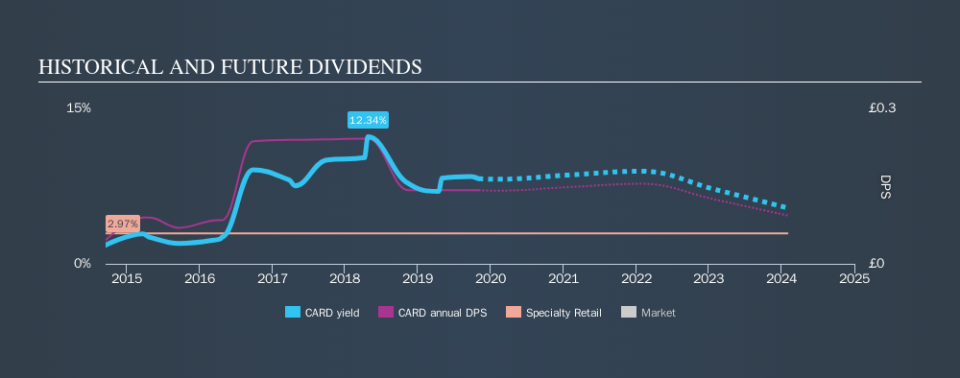Just 3 Days Before Card Factory plc (LON:CARD) Will Be Trading Ex-Dividend

Card Factory plc (LON:CARD) stock is about to trade ex-dividend in 3 days time. You can purchase shares before the 7th of November in order to receive the dividend, which the company will pay on the 19th of December.
Card Factory's next dividend payment will be UK£0.08 per share, on the back of last year when the company paid a total of UK£0.1 to shareholders. Last year's total dividend payments show that Card Factory has a trailing yield of 8.3% on the current share price of £1.729. Dividends are a major contributor to investment returns for long term holders, but only if the dividend continues to be paid. So we need to investigate whether Card Factory can afford its dividend, and if the dividend could grow.
See our latest analysis for Card Factory
Dividends are typically paid from company earnings. If a company pays more in dividends than it earned in profit, then the dividend could be unsustainable. Card Factory is paying out an acceptable 66% of its profit, a common payout level among most companies. Yet cash flows are even more important than profits for assessing a dividend, so we need to see if the company generated enough cash to pay its distribution. Dividends consumed 73% of the company's free cash flow last year, which is within a normal range for most dividend-paying organisations.
It's positive to see that Card Factory's dividend is covered by both profits and cash flow, since this is generally a sign that the dividend is sustainable, and a lower payout ratio usually suggests a greater margin of safety before the dividend gets cut.
Click here to see the company's payout ratio, plus analyst estimates of its future dividends.
Have Earnings And Dividends Been Growing?
Companies with consistently growing earnings per share generally make the best dividend stocks, as they usually find it easier to grow dividends per share. If earnings decline and the company is forced to cut its dividend, investors could watch the value of their investment go up in smoke. For this reason, we're glad to see Card Factory's earnings per share have risen 13% per annum over the last five years. Card Factory has an average payout ratio which suggests a balance between growing earnings and rewarding shareholders. Given the quick rate of earnings per share growth and current level of payout, there may be a chance of further dividend increases in the future.
Another key way to measure a company's dividend prospects is by measuring its historical rate of dividend growth. Card Factory has delivered 25% dividend growth per year on average over the past five years. It's exciting to see that both earnings and dividends per share have grown rapidly over the past few years.
To Sum It Up
Has Card Factory got what it takes to maintain its dividend payments? Higher earnings per share generally lead to higher dividends from dividend-paying stocks over the long run. However, we'd also note that Card Factory is paying out more than half of its earnings and cash flow as profits, which could limit the dividend growth if earnings growth slows. In summary, it's hard to get excited about Card Factory from a dividend perspective.
Ever wonder what the future holds for Card Factory? See what the six analysts we track are forecasting, with this visualisation of its historical and future estimated earnings and cash flow
We wouldn't recommend just buying the first dividend stock you see, though. Here's a list of interesting dividend stocks with a greater than 2% yield and an upcoming dividend.
We aim to bring you long-term focused research analysis driven by fundamental data. Note that our analysis may not factor in the latest price-sensitive company announcements or qualitative material.
If you spot an error that warrants correction, please contact the editor at editorial-team@simplywallst.com. This article by Simply Wall St is general in nature. It does not constitute a recommendation to buy or sell any stock, and does not take account of your objectives, or your financial situation. Simply Wall St has no position in the stocks mentioned. Thank you for reading.

 Yahoo Finance
Yahoo Finance 
